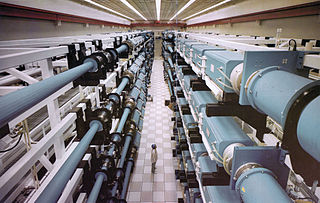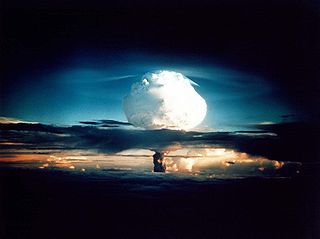Related Research Articles

Inertial confinement fusion (ICF) is a fusion energy research program that initiates nuclear fusion reactions by compressing and heating targets filled with thermonuclear fuel. In modern machines, the targets are small spherical pellets about the size of a pinhead typically containing a mixture of about 10 milligrams of deuterium 2H and tritium 3H.
This timeline of nuclear fusion is an incomplete chronological summary of significant events in the study and use of nuclear fusion.

The National Ignition Facility (NIF) is a large laser-based inertial confinement fusion (ICF) research device, located at the Lawrence Livermore National Laboratory in Livermore, California. NIF uses lasers to heat and compress a small amount of hydrogen fuel with the goal of inducing nuclear fusion reactions. NIF's mission is to achieve fusion ignition with high energy gain, and to support nuclear weapon maintenance and design by studying the behavior of matter under the conditions found within nuclear weapons. NIF is the largest and most energetic ICF device built to date, and the largest laser in the world.
The Laboratory for Laser Energetics (LLE) is a scientific research facility which is part of the University of Rochester's south campus, located in Brighton, New York. The lab was established in 1970 and its operations since then have been funded jointly; mainly by the United States Department of Energy, the University of Rochester and the New York State government. The Laser Lab was commissioned to serve as a center for investigations of high-energy physics, specifically those involving the interaction of extremely intense laser radiation with matter. Many types of scientific experiments are performed at the facility with a strong emphasis on inertial confinement, direct drive, laser-induced fusion, fundamental plasma physics and astrophysics using the Omega Laser Facility. In June 1995, OMEGA became the world's highest-energy ultraviolet laser. The lab shares its building with the Center for Optoelectronics and Imaging and the Center for Optics Manufacturing. The Robert L. Sproull Center for Ultra High Intensity Laser Research was opened in 2005 and houses the OMEGA EP laser, which was completed in May 2008.

A fusion energy gain factor, usually expressed with the symbol Q, is the ratio of fusion power produced in a nuclear fusion reactor to the power required to maintain the plasma in steady state. The condition of Q = 1, when the power being released by the fusion reactions is equal to the required heating power, is referred to as breakeven, or in some sources, scientific breakeven.

The Shiva laser was a powerful 20-beam infrared neodymium glass laser built at Lawrence Livermore National Laboratory in 1977 for the study of inertial confinement fusion (ICF) and long-scale-length laser-plasma interactions. Presumably, the device was named after the multi-armed form of the Hindu god Shiva, due to the laser's multi-beamed structure. Shiva was instrumental in demonstrating a particular problem in compressing targets with lasers, leading to a major new device being constructed to address these problems, the Nova laser.

Nova was a high-power laser built at the Lawrence Livermore National Laboratory (LLNL) in California, United States, in 1984 which conducted advanced inertial confinement fusion (ICF) experiments until its dismantling in 1999. Nova was the first ICF experiment built with the intention of reaching "ignition", a chain reaction of nuclear fusion that releases a large amount of energy. Although Nova failed in this goal, the data it generated clearly defined the problem as being mostly a result of Rayleigh–Taylor instability, leading to the design of the National Ignition Facility, Nova's successor. Nova also generated considerable amounts of data on high-density matter physics, regardless of the lack of ignition, which is useful both in fusion power and nuclear weapons research.
In radiation thermodynamics, a hohlraum is a cavity whose walls are in radiative equilibrium with the radiant energy within the cavity. This idealized cavity can be approximated in practice by making a small perforation in the wall of a hollow container of any opaque material. The radiation escaping through such a perforation will be a good approximation to black-body radiation at the temperature of the interior of the container.
An inertial fusion power plant is intended to produce electric power by use of inertial confinement fusion techniques on an industrial scale. This type of power plant is still in a research phase.
Laser Mégajoule (LMJ) is a large laser-based inertial confinement fusion (ICF) research device near Bordeaux France, built by the French nuclear science directorate, Commissariat à l'Énergie Atomique (CEA).

Argus was a two-beam high power infrared neodymium doped silica glass laser with a 20 cm (7.9 in) output aperture built at Lawrence Livermore National Laboratory in 1976 for the study of inertial confinement fusion. Argus advanced the study of laser-target interaction and paved the way for the construction of its successor, the 20 beam Shiva laser.
The High Power laser Energy Research facility (HiPER), is a proposed experimental laser-driven inertial confinement fusion (ICF) device undergoing preliminary design for possible construction in the European Union. As of 2019, the effort appears to be inactive.
Magnetized Target Fusion (MTF) is a fusion power concept that combines features of magnetic confinement fusion (MCF) and inertial confinement fusion (ICF). Like the magnetic approach, the fusion fuel is confined at lower density by magnetic fields while it is heated into a plasma. As with the inertial approach, fusion is initiated by rapidly squeezing the target to greatly increase fuel density and temperature. Although the resulting density is far lower than in ICF, it is thought that the combination of longer confinement times and better heat retention will let MTF operate, yet be easier to build. The term magneto-inertial fusion (MIF) is similar, but encompasses a wider variety of arrangements. The two terms are often applied interchangeably to experiments.
Fusion ignition is the point at which a nuclear fusion reaction becomes self-sustaining. This occurs when the energy being given off by the fusion reactions heats the fuel mass more rapidly than various loss mechanisms cool it. At this point, the external energy needed to heat the fuel to fusion temperatures is no longer needed. As the rate of fusion varies with temperature, the point of ignition for any given machine is typically expressed as a temperature.

Magnetized Liner Inertial Fusion (MagLIF) is an emerging method of producing controlled nuclear fusion. It is part of the broad category of inertial fusion energy (IFE) systems, which drives the inward movement of fusion fuel, thereby compressing it to reach densities and temperatures where fusion reactions occur. Previous IFE experiments used laser drivers to reach these conditions, whereas MagLIF uses a combination of lasers for heating and Z-pinch for compression. A variety of theoretical considerations suggest such a system will reach the required conditions for fusion with a machine of significantly less complexity than the pure-laser approach. There are currently at least two facilities testing feasibility of the MagLIF concept, the Z-machine at Sandia Labs in the US and Primary Test Stand (PTS) located in Mianyang, China.
KMS Fusion was the first private company to attempt to produce a fusion reactor using the inertial confinement fusion (ICF) approach. The basic concept, developed in 1969 by Keith Brueckner, was to infuse small glass spheres with a fuel gas and then compress the sphere using lasers until they reached the required temperature and pressures. In May 1974 they demonstrated neutron output consistent with small levels of fusion events in a D-T filled target, the first published success for this technique.

LIFE, short for Laser Inertial Fusion Energy, was a fusion energy effort run at Lawrence Livermore National Laboratory between 2008 and 2013. LIFE aimed to develop the technologies necessary to convert the laser-driven inertial confinement fusion concept being developed in the National Ignition Facility (NIF) into a practical commercial power plant, a concept known generally as inertial fusion energy (IFE). LIFE used the same basic concepts as NIF, but aimed to lower costs using mass-produced fuel elements, simplified maintenance, and diode lasers with higher electrical efficiency.
John D. Lindl is an American physicist who specializes in inertial confinement fusion (ICF). He is currently the Chief Scientist of the National Ignition Facility at the Lawrence Livermore National Laboratory.
Heavy ion fusion is a fusion energy concept that uses a stream of high-energy ions from a particle accelerator to rapidly heat and compress a small pellet of fusion fuel. It is a subclass of the larger inertial confinement fusion (ICF) approach, replacing the more typical laser systems with an accelerator.
The history of nuclear fusion began early in the 20th century as an inquiry into how stars powered themselves and expanded to incorporate a broad inquiry into the nature of matter and energy, as potential applications expanded to include warfare, energy production and rocket propulsion.
References
Citations
- ↑ Nuckolls, John; Wood, Lowell; Thiessen, Albert; Zimmerman, George (15 September 1972). "Laser Compression of Matter to Super-High Densities: Thermonuclear (CTR) Applications". Nature . 239 (5368): 139–142. Bibcode:1972Natur.239..139N. doi:10.1038/239139a0. S2CID 45684425.
- 1 2 3 4 5 6 7 Seife 2008.
- ↑ Zimmerman 1977.
- ↑ Jeff Tollefson, , Nature, 27 October 2021
- ↑ Christopher Paine & Matthew McKinzie, "When Peer Review Fails: The Roots of the National Ignition Facility (NIF) Debacle", NDRC, 2000
- ↑ John Lindl et al, "Progress Towards Ignition and Burn Propagation in Inertial Confinement Fusion", Physics Today, September 1992, p. 37
- ↑ Shestakov, A.I.; Prasad, M.K.; Milovich, J.L.; Gentile, N.A.; Painter, J.F.; Furnish, G. (2000). "The radiation-hydrodynamic ICF3D code". Computer Methods in Applied Mechanics and Engineering. 187 (1–2): 181–200. Bibcode:2000CMAME.187..181S. doi:10.1016/S0045-7825(99)00117-6.
- ↑ "New Features in Nuclear Diagnostic Modeling Using HYDRA", 55th Annual Meeting of the APS Division of Plasma Physics, 2013
Bibliography
- Seife, Charles (2008). Sun in a Bottle: The Strange History of Fusion and the Science of Wishful Thinking. Penguin. ISBN 9781101078990.
- Zimmerman, G. (6 October 1977). The LASNEX Code for Inertial Confinement Fusion (PDF) (Technical report). Lawrence Livermore Laboratory.
- Zimmerman, G. (1996). "LASNEX—A 2-D Physics Code For Modeling ICF" (PDF). Inertial Confinement Fusion. Lawrence Livermore Laboratory. pp. 150–164.